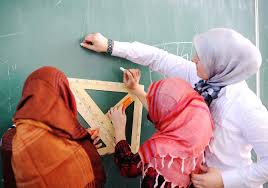Wearing a Hijab in High School

by Hena Hussain ‘20 and Anjali Verma ‘20
According to Pew Research Center, 1.1 percent of the US population identify as Muslims (people who follow the religion of Islam), which is expected to double in percentage by 2050. A common practice among Muslim women is wearing a hijab, or a headscarf worn to project modesty and moral character. However, this practice has been the subject of countless acts of discrimination and in extreme cases, violence, throughout the world due to the surge in Islamophobic attitudes. Although the animosity towards Sherwood students who wear hijab is less pronounced, they still face varying degrees of hostility both in and outside of school.
“A few people that are in class with me that may not know me that well are hesitant to interact with me or talk to me,” said junior Saarah Haqq, who has been wearing a hijab since sixth grade. “They kind of view us as being shut out … they don’t know that it’s your choice and reasons behind it.”
Haqq also mentioned that she encounters negative attitudes as a member of the varsity field hockey team. “When we high-five the other team in a line, lots of people miss my hand on purpose,” Haqq said. “It has happened at every game since I was a freshman.”
She also spoke about feeling as though the school doesn’t do enough to counteract incidents of bullying and harassment.
“I go to counselors, but then they say contact administration. [In previous years when] had a couple of issues, they wouldn’t do anything.” Haqq says that even after reporting one incident of teasing several times during freshman year, she never received a response or guidance on further action.
Such unfavorable attitudes are also felt outside of school by students who wear hijab. “In public settings, people always give me strange looks,” said sophomore Maryam Higazi, who has been wearing hijab since middle school as well. However, Higazi said that she feels that Sherwood is a safe environment, and that people at school are open and accepting.
“I do face negativity. It’s not as much in school as it is outside,” Higazi said. “Outside of school, it’s mostly people just giving me strange looks, but rarely will someone say something negative to me.”
As a member of the varsity volleyball team, Higazi also faces a certain set of challenges. “Wearing a hijab affects my athletic life because of how I have to change the traditional uniform,” Higazi said. “With referees, I have had some trouble in the past with them saying I couldn’t play with [a hijab] on because it’s not a part of the team uniform.”
However, these obstacles are worth it for Higazi to continue practicing what she views as an integral part of her faith. “Being a [person wearing hijab] in high school comes with its difficulties,” she said. “But staying true to my religion has made me spiritually stronger.”
She also expressed her desire for people to stop misjudging women who wear hijab. “I want people to think of [women who wear hijab] as strong, spiritual, and modest women who are intelligent, independent, and empowered.”
Haqq echoed this sentiment. “Don’t underestimate someone because they look a certain way,” she said. She also wants people to understand the idea behind wearing a hijab, and that while women who wear a hijab may live one way, they accept every person as they are no matter what religious practices they follow.